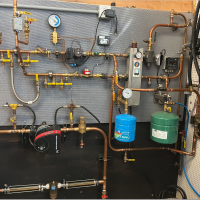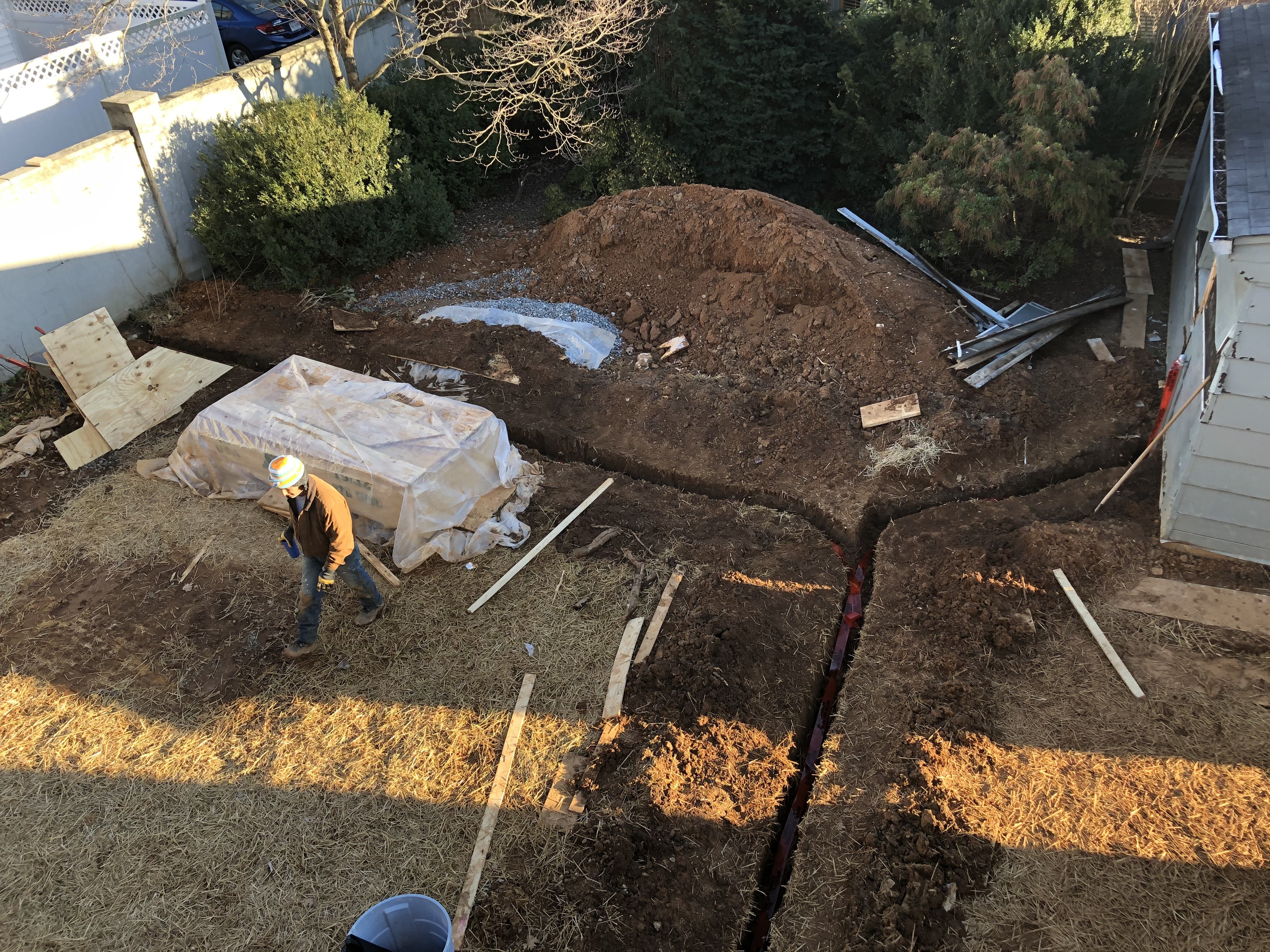OT: Underground Wiring Options

In doing some landscaping we found that the 30-40ft underground electric line from the house to the garage (20amps) was buried less than 12" below grade, so within a week or so we hope to have our landscaper trench out at a depth of 18" at the width of a shovel(?) for a new line. According to code I understand that sand will be filled in first, then the pvc electric conduit, then more sand and then the caution tape to warn any future excavators.
Since this is replacing an existing line the electrician has suggested installing two connecting outside boxes, one at the garage end, and the other on the house wall so that the internal wiring in the house and in the garage can be left as is.
He also gave us the option of installing 2 50-amp conductors for a future car battery charger, while leaving the existing house connectors the same until such a charger is installed—which would save any new owner the cost of re-trenching through the new finished landscaping. That leads me to these questions:
1-Since we intend no such charger and would use only the 20-amp circuit for garage lights and a power outlet, would that 20 line be Y-ed to work with the 50-amp battery charger line which would eventually be a double breaker? Or would the two circuits have to be wired separately? I am thinking the wise option is to run just a PVC 20-amp circuit INSIDE a larger 2-3" pvc sleeve so they could snake a future larger charger line with no re-trenching and let the eventual new owners worry about it.
2-What are the wiring thickness gauges required for the 20amp and 50amp underground lines?
Comments
-
for the cost difference in the larger PVC, why not leave the option for a 50 or 100A upgrade?
1-1/2” PVC would be my suggestion
I believe 18” burial, 12” under driveways is how the code reads
I put yellow caution tape in the trench a few inches above the conduit
Bob "hot rod" Rohr
trainer for Caleffi NA
Living the hydronic dream3 -
When I did the construction of an addition for my existing house with new service, I ran a one and a half inch line from house to garage in a 2 inch out to the connection point for the mains.
If I did it again, I would run a 3 inch out to the connection point for the mains. It was a pain pulling the aluminum supply lines through the 2 inch PVC with two long 90 in line.
Do yourself a favor and leave a couple pull strings inside the run to the garageThe inspector required metallic detectable tape to be installed above the lines.
1 -
@hot_rod So you're saying run both a 20-amp line AND the 50 or 100amp line side by side in a 1.5" PVC into the boxes at both ends and connect the larger line as needed. 100-amp is smart in case the 20car garage is someday made occupiable.
And the gauge of those lines would be thick enough to reach no more than 80% of rated capacity, yes?—taking into account the distance.
Thanks!
0 -
-
I would run maybe a 1" for the 20A you want now, run a second spare conduit for the 100A in the future.
If you run the 100A now, eliminate the 20A and just set a sub panel
We are working on an ADU in our detached shop, we have capacity for a second 100A for that building.
I'd contact an electrician for wire and conduit sizing for that distance.
Around here you need a permit, licensed electrician and inspection before the power company will do the service upgrade.
Bob "hot rod" Rohr
trainer for Caleffi NA
Living the hydronic dream2 -
Whatever else you do, unless for some reason you need two independent circuits out there, just run the bigger conduit and wire for 50 or 100 amps. The extra cost in comparison with the digging and electrician's time is trivial.
Br. Jamie, osb
Building superintendent/caretaker, 7200 sq. ft. historic house museum with dependencies in New England1 -
@hot_rod I'm happy to run the 100amp wire between house and garage, but don't want to deal with subpanel permit etc for now, so if I just run the 100amp wire for now, leave the circuits and house panel breaker at 20amps, then I shouldn't need a subpanel until a 100 amp breaker is actually in use, yes?
0 -
If your not going to have a charger run the larger PVC pipe and pull #12 for the 20 amp breaker. The new owner can pull the charger circuit or the sub panel. Only install what you need but you have left provisions for an upgrade if needed.
A garage can only have 1 circuit or 1 multiwire branch circuit. More than that and you open yourself up to ground rods, sub panels and more unneeded cost and issues you don't need if your not using the increased power.
2 -
I'd run a 20a mulitwire circuit. The difference of the cost of the wire between 20a and 100a is large so I'd probably jsut run 1.5" or 2" conduit with #12 or #10 in it depending on the length of the run and pull the bigger conductors later if I needed to change it to having its own service instead of using the 1 circuit exception.
It is very likely that by the time you want to increase the capacity it will be something completely different than what you think you want now.
The codes are all online now, someone decided that you couldn't copyright regulations.
1 -
-
Very good point Matt, I've wanted to run a low voltage to garage but am stuck due to the NEC language limiting Class 2 circuit in same conduit as Class 1. Would have been very simple to throw another 1" conduit in the trench when it was as open
0 -
IIWM, I would bury 1 1/2" PVC with J-box at each building. 40' with 2 sweep 90's is no problem for 100 amp wire, even aluminum.
Then just pull in the 20 amp multibranch circuit, giving you 2 circuits in the garage.
When and if you want the 100 Amp sub feed panel in the garage, then pull larger conductors using the #12's as pull wires.
I have seen someone go to a lot of work to get an 18-2 cable to their garage from their house just to run the door opener.
And I wondered why they did not just get another visor mounted remote control to have in the house. One neighbor just keeps the remote in her house and keeps it in the car as she leaves. Once back home takes it inside again.
However, the empty 1" PVC is not a bad idea……door openers…..remote door chimes in garage…..cat 6 computer cable….. and, the today unheard of, land line phone extension….etc.
1 -
" so within a week or so we hope to have our landscaper trench out at a depth of 18" "
Deeper than 18". The top of the PVC conduit needs 18" of cover, not an 18" trench. So if you use a 1-1/2" which is the best part of 2" Outer diameter and if it is in sand, you need a deeper trench.
I would and have done three conduits;
one high current 1-1/2 or 2" (in your case not populated)
one 3/4" or 1" for low current branch circuit and
one 3/4" or 1" for low voltage or communications type stuff.
With better protection of the wire the burial depth is less.
National - U.S. Gas Boiler 45+ Years Old
Steam 300 SQ. FT. - EDR 347
One Pipe System3 -
As an extra precaution, I always place the "Caution Buried Cable" or "Natural gas" tape 6-8 inches below the grade also. I do this because I've seen overly exuberant diggers chopper right through the tape and pipe or cable, ignoring the caution tape. The tape is cheap enough. Mad Dog
2 -
-
-
@Dyingtofly Yes that's a great idea. For car washing our house hose is fine but your idea is a great one especially for a potential future ADU, but I'm afraid at this stage of the project and the required lead time for permits, etc. that's just beyond us.
0 -
-
Well since this basically a repair/replacement of a long-existing line with same amperage and we have to close trench and restore service immediately, then we hope to avoid needing a permit until an upgrade is needed. We will take plenty of photos though of trench and pvc depth etc. (Prior homeowner's contractor had buried line less than 12".)
0 -
-
Depending on your local ordinances a permit may be required for the work you are presently doing. Also some inspectors get weird about the use of an underground conduit if the trench was back filled without it ever being inspected. I guess take good picture of the quality and depth.
National - U.S. Gas Boiler 45+ Years Old
Steam 300 SQ. FT. - EDR 347
One Pipe System1 -
-
@mattmia2 Yes, well our electrical guys are long-time licensed contractors in our County and we'll have plenty of photos so I think we're good. Bottom line all these years we lived here we assumed the line was buried properly and now it finally will be.
Thanks for all the suggestions from you Wallees for providing the details and knowledge no electrician would have the time to explain to me.
0 -
The underground conduits I have had inspected I have always backfilled them after running the pipe but kept 2 3' sections open for the inspectors.
0 -
-
Here we can get UG approval with a picture of trench with yardstick showing depth.
Text it to the inspector and get his reply back pretty quickly.
0 -
@hot_rod Interesting on the spare pvc. So job was done today 1.5" pvc with the 20amp line, and spare 3/4" pvc for future low voltage line. So I'll assume that even though a low voltage and/or ethernet cable PLUS a pex could fit in the 3/4" pvc, it probably wouldn't be legal. But another 3/4" PVC line now would be a very wise choice. Problem is trench is being filled Monday. It has plenty of room for another 3/4" pvc line so theoretically if I run just an empty 40 ft pvc line and bury it at both ends a future connection could be made by just digging it up at the ends. Possible? It's Friday night and I'd probably have to buy and run and join the pvc segments myself. AND my car is stuck in the garage this weekend by construction materials…..
0 -
I'd probably do like 2". You can use 4" black plastic drain tile too, can pull things that don't have much of a code requirement in that like direct bury low energy wiring and maybe water. There seem to be few rules about buried water piping. If you do conduit, bury it and put some plumbing caps on the ends, digging up the ends and connecting is much easier than digging another trench.
1 -
" So I'll assume that even though a low voltage and/or ethernet cable PLUS a pex could fit in the 3/4" pvc, it probably wouldn't be legal. But another 3/4" PVC line now would be a very wise choice. "
Even if you intend to put 1/2" PEX through 3/4" PVC you may be severely disappointed. 1/2" PEX has an outer diameter of about 5/8". Between the bend radius and any excessive glue that oozed into the conduit you may never get it through.
With electrical conduit work they only allow 40% (3 or more conductors), 53% (1 conductor) fill of the conduits available cross-sectional area.
As @mattmia2 stated you need to think much bigger. And use electrical conduit type radius not water pipe type radius.
National - U.S. Gas Boiler 45+ Years Old
Steam 300 SQ. FT. - EDR 347
One Pipe System2 -
Thanks all, I think I've reached the limit of future conduits. Even if I could get a water line through for some future ADU, running a sewer line would be about 80ft to the street, not something I'd ever want to contemplate.
Part of the trench was through a portal in a foot-thick wall. I will measure that location carefully for any future use and count my blessings that my garage electric is now repaired, working, buried correctly and there is PVC conduit available for a 100amp future line plus a 3/4 empty line for low-voltage/ethernet possibilities.
1 -
Categories
- All Categories
- 87.4K THE MAIN WALL
- 3.2K A-C, Heat Pumps & Refrigeration
- 61 Biomass
- 429 Carbon Monoxide Awareness
- 120 Chimneys & Flues
- 2.1K Domestic Hot Water
- 5.8K Gas Heating
- 115 Geothermal
- 168 Indoor-Air Quality
- 3.7K Oil Heating
- 77 Pipe Deterioration
- 1K Plumbing
- 6.5K Radiant Heating
- 395 Solar
- 15.7K Strictly Steam
- 3.4K Thermostats and Controls
- 56 Water Quality
- 51 Industry Classes
- 50 Job Opportunities
- 18 Recall Announcements








